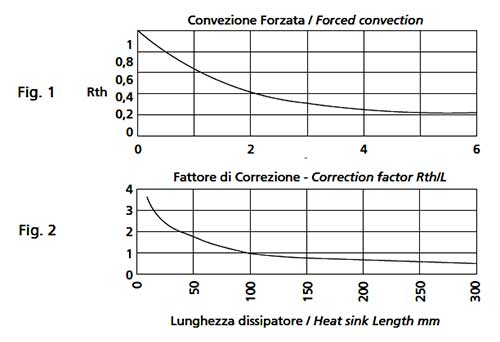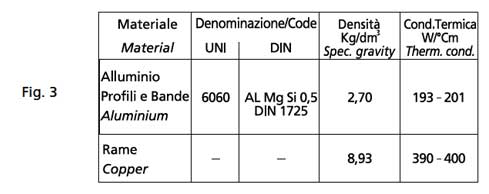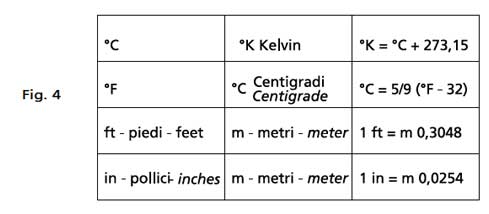1) THERMAL MANAGEMENT – INTRODUCTION
A correct design of solid state electronics requires not to exceed maximum allowed Junction Temperature (Tj) of semiconductors.
Power semiconductors, in order to work at the rated power level, need a heat sink system otherwise the max allowed Tj is exceeded and the device is destroyed.
Heat sinks transfer heat from semiconductors to surrounding ambient.
This keeps semiconductor temperature (Tj) below the specified limits thus improving reliability and life of electronic products.
Heat transmission between two objects occurs through three possible paths:
- Conduction
- Convection
- Radiation
Conduction is the most efficient way, it is normally used between semiconductor and heat sink and requires a tight contact between parts.
On the contrary the heat sink transmits the heat to the surrounding air by Convection (natural or forced) and by Radiation.
Another important parameters to be considered is Thermal Conductivity of the material used to make the heat sink.
The higher is the thermal conductivity, the better is the heat sink performance, therefore, considering the ratio between performance and price, the best available material is Aluminum.
Generally speaking, heat sink performances depend on:
- Material
- Size
- Shape
- Color
- Surface finishing (Radiation)
- Convection (natural/forced)e
- Mounting position
- Displacement of devices on the heat sink
The heat sink performance is measured by its Thermal Resistance (Rth)
where Rth is the temperature increase (ΔT) in degrees Centigrade caused by the application of the power of one Watt.
As soon as do not exist national or international test methods to evaluate Rth, the values given in this catalog come from laboratory tests. The set up used during the laboratory tests are similar to practical working conditions and the data obtained are useful to make the choice of the heat sink type and to make a rough evaluation of the working conditions.
Customers are strongly advised to carry out a practical verification, considering the real and most severe working condition in order to take into account all the parameters that can influence the heat transmission in their particular application.
2) HOW TO SELECT A HEAT SINK
In order to select a heat sink, the following parameters are needed:
- Max Power to be dissipated by the device (Watts)
- Max Junction Temperature and Thermal Resistance of the device
- Max Ambient Air Temperature
- Air flow on the heat sink surface
The basic equation is:
where:
Rtja total thermal resistance from junction to ambient
Rtjc thermal resistance junction to case (given by the device manufacturer)
Rtcd thermal resistance from case to heat sink (takes into account the contact between device and heat sink, particularly insulating sheets or thermal grease)
Rth thermal resistance of the heat sink derived from catalogue
The second equation to be used is:
where:
Tjm = maximum junction temperature acceptable for the design under evaluation.
Ta = ambient temperature.
P power to be dissipated (Watts).
Solving equation 2) and replacing Rtja into equation 1), Rth is determined:
This is the max Rth value allowed tor the heat sink.
Example
| Design data: | |
| Semiconductor type | = T03 |
| Tj max | = 150 °C |
| Ta max | = 50 °C |
| P to dissipate | = 5W |
| Convection | = natural |
| Rtl | = 1° C/W |
| Rtcd | = 0,1° C/W |
1) Rtja = Rtjc + Rtcd + Rth that gives Rth = Rtja – Rtjc – Rtcd
Rth max = Rtja max – Rtjc – Rtcd = 20 – 1 – 0,1 = 18,9° C/W max admitted value.
Type 517 heat sink meets the requirements needed because has Rth = 16° C/W that is lower than 18,9° C/W (max admitted value).
3) LABORATORY TESTS
The Thermal Resistance values of heat sinks come from laboratory tests carried out in the following conditions:
- Black anodized heat sink
- Vertical set up in free air allowing natural convection
- Heat source positioned at the center of heat sink
- Direct contact between source and heat sink with thermal greased interposed
- Heat sink temperature measurement made in the hottest point
- Ambient air temperature measured at 1 m distance from heat sink
The temperature measurement are made with miniaturized thermocouples positioned in tight contact with the heat sink. The heat sink is suspended into an ambient with steady air condition. The ambient temperature is controlled and constant.
4) SURFACE FINISH
Surface finish primarily influences heat radiation.
The data given refer to black anodizing. Unfinished heat sink are less efficient and Thermal Resistance increases by 10%.
5) FORCED CONVENCTION
Forced convection improves the efficiency of heat sinks depending from air speed (see Fig. 1).
6) HEAT SINK LENGTH
As the length of a heat sink increases, so does the capability to dissipate heat, but the thermal resistance is not directly proportional to the additional length (see Fig. 2).
7) TEMPERATURE INCREASE (DT)
As the heat sink temperature increases, so does the capability to dissipate heat. During the laboratory tests a temperature increase (ΔT) of 60° C with an ambient temperature of 25° C is considered.
The influence of temperature increase on Rth changes with the profile shape, therefore precise indications on the influence of this parameter cannot be given.

8) HEAT SINK MOUNTING
Mounting position influences the heat sink thermal resistance Rth.
The most effcient mounting position is the one with vertical fins, any other mounting gives worse result. Particularly, horizontal mounting increasesi Rth by 20%.
9) SPECIAL PRODUCTS, MACHINING AND FINISH
- Special product: Over 300 types and extrusion protiles that are available and new protiles are continually being added. lf the desired shape or protile is not found in the catalogue, please consult our Customer Service Department. New shapes and extrusion profiles to meet specific customer requirements can be provided.
- Material: if otherwise not specified, the products shown in the catalogue are made of aluminum.
- Delivery time: Ellediesse has a large stock of raw materiai that allows a quick reaction to customer request.
- Mechanical machining: all the production steps are performed in house with CNC machinery that allow high precision product.
Heat sinks up to a length of 1600 mm can be machined.
Machining can be done along all three axes. - Length cut profiles: Ellediesse an provide raw protifes length cut according to customer request.
- Finish: the following finish are available:
- Black anodize
- Color anodize
- Alodine (1000/1200, transparent/yellow)
- Hard anodize
- Raw
- Sand blasted.
10) USEFUL SUGGESTION
- For ΔT > 40°C it is recommended the use of black anodized heat sinks and, when possible, the use of metal to metal joints without the use of insulating foils.
- lnstall heat sink with vertical fins and as far as possible from parts that could limit air flow.
- If the heat sink has a rectangular shape, the lower side should be vertical, as well as fins.
- If more than one device is placed on a single heat sink it is advised to displace them on the lower part in asymmetrical position.
- Heat sinks with a length to base ratio higher than 4 should be checked practically because turbulence could prevent normal thermal exchange.
11) TECHNICAL ASSISTANCE
Our Technical Department can assist you to select the heat sink that meets your thermal and configuration needs.
12) TECHNICAL DATA – CONVERSION CHART
- MATERIALS USED FOR HEAT SINK PRODUCTION (see Fig. 3)

- CONVERSION TABLE (see Fig. 4)

13) PRODUCT LIABILITY
Information provided in this catalogue is believed to be accurate and reliable as of publication date. Our customers are reminded that they bear the responsibility tor testing the products because Ellediesse is not aware of all potential uses.
Ellediesse makes no warranties as to the fitness and suitability of any L.D.S SYSTEM product tor any specific or general use.
L.D.S SYSTEM shall not be liable for direct or indirect damages during the use of the product, Ellediesse reserves the right to modify its products without notice to improve the design or performance characteristics.
Supply and delivery terms are described into the general sales conditions applied by Ellediesse.
FLATNESS TOLERANCES ON EXTRUDED PROFILES
(This document refers to UNI EN 755-9 paragraph 4.3)
Convexity and concavity must be measured as shown in the figure below.
The maximum allowed deviation for convexity-concavity of filled and hollow profiles must be as specified in the table.
 |
|||
| Width W | Deviation F Wall thickness t <= 5 |
Deviation F Wall thickness t > 5 |
|
| > di | <= di | ||
| 0 | 30 | 0,3 | 0,2 |
| 30 | 60 | 0,4 | 0,3 |
| 60 | 100 | 0,6 | 0,4 |
| 100 | 150 | 0,9 | 0,6 |
| 150 | 200 | 1,2 | 0,8 |
| 200 | 300 | 1,8 | 0,9 |
| 300 | 400 | 2,4 | 1,2 |
| 400 | 500 | 3 | 1,6 |
| 500 | 600 | 3,6 | 2,4 |
| 600 | 800 | 4 | 3 |
N.B.
In the event of filled or hollow profiles wfth width W of min. 150 mm, the deviation F1 shall not exceed 0.7 mm every 100 mm of width W1.
In the event of tolerances given on the drawing in well-defined points, you are requested to specify them onto take agreement with a technical organization.
